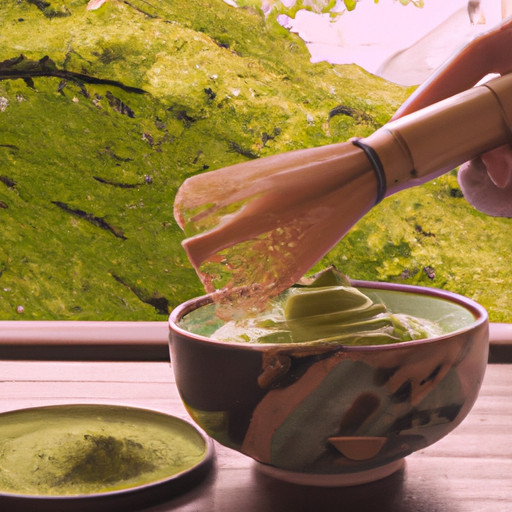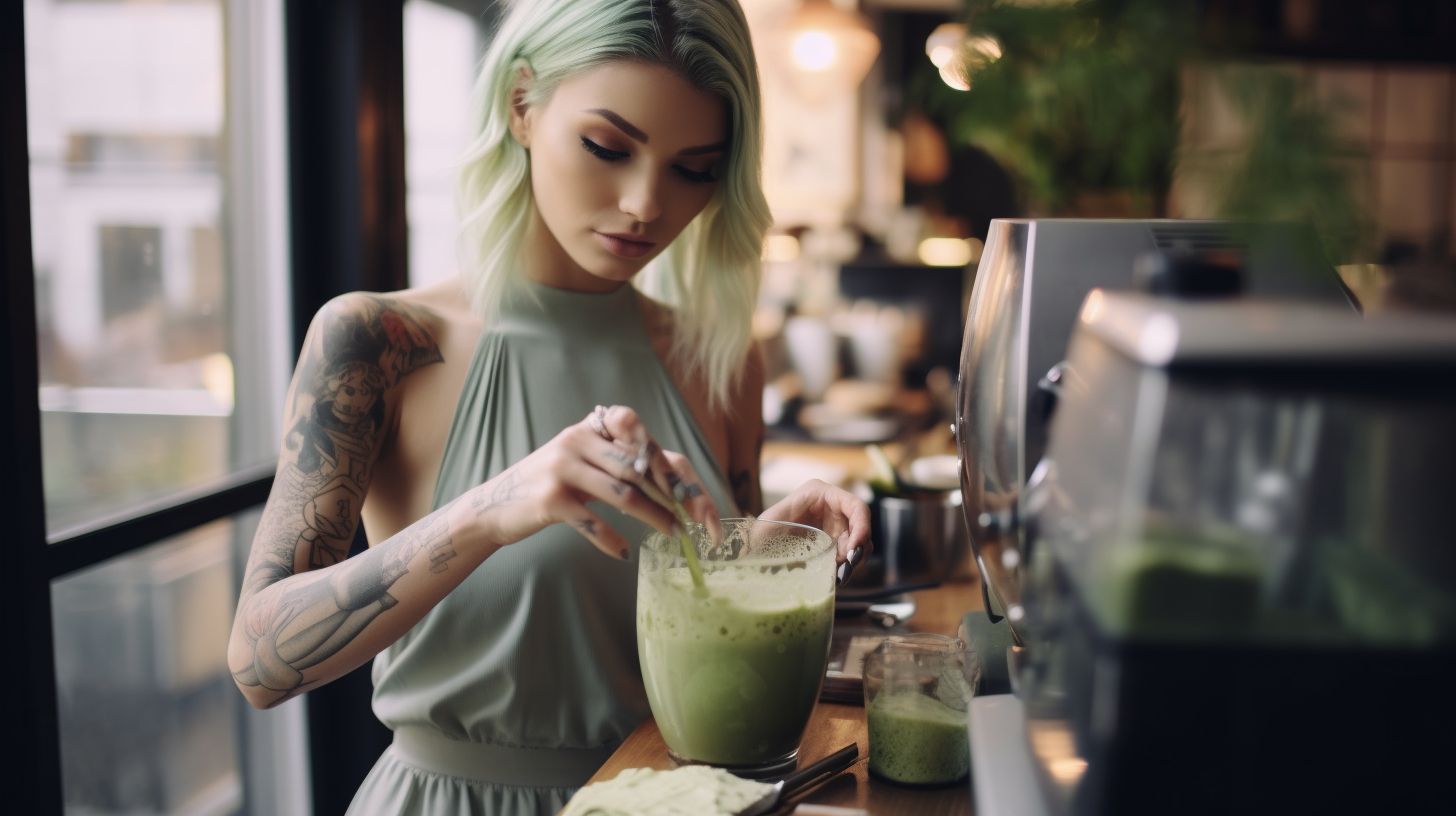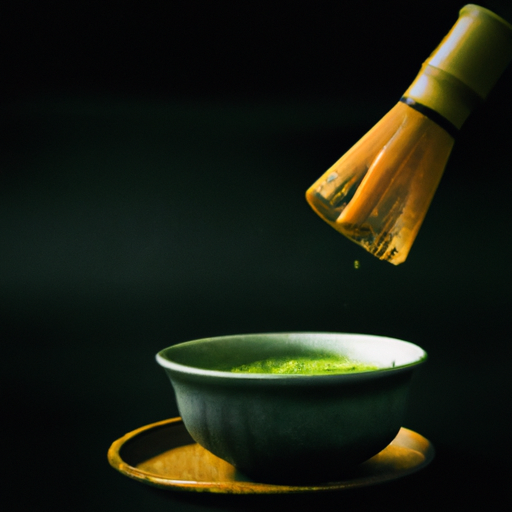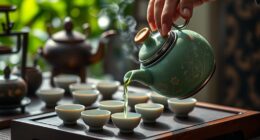Being a fan of matcha, the dalgona coffee craze has always caught my interest. However, why should coffee be the only star? After some tinkering, I found out that matcha dalgona is equally delightful and simple to prepare!
In this article, I will guide you through the steps to create your own creamy and frothy matcha dalgona at home.
Before we start, it’s important to gather all necessary ingredients and equipment. You’ll need high-quality matcha powder, granulated sugar, heavy cream or whipping cream, milk of your choice (I prefer almond milk), and ice cubes for serving.
For equipment, you’ll need a whisk (either electric or handheld), a mixing bowl, and a glass for serving.
Now that we have everything ready, let’s get started on making our perfect cup of matcha dalgona!
Key Takeaways
- Matcha dalgona requires high-quality matcha powder, granulated sugar, heavy cream or whipping cream, milk, ice cubes, honey, agave nectar, almond milk, coconut milk, vanilla extract, cinnamon powder, grated ginger, and fruit puree.
- Equipment needed includes a whisk, mixing bowl, glass for serving, and bamboo matcha whisk.
- Health benefits of matcha include high antioxidant content, immune system boosting, and preventing chronic diseases.
- Matcha dalgona can be served hot or cold, topped with whipped cream, chocolate chips, or fresh fruit, and flavored with vanilla extract or different types of sweeteners. Alternative ingredients for whipped cream include coconut cream and aquafaba.
Gather Your Ingredients
You’ll need to gather all of your ingredients before you can start making matcha dalgona, so grab that shopping list and head to the store! The basic recipe requires just four ingredients: matcha powder, sugar, hot water, and milk. However, there are ingredient alternatives you can use if you prefer a different taste or have dietary restrictions.
For instance, instead of regular sugar, you can use honey or agave nectar. You can also substitute regular milk with almond milk or coconut milk for a vegan-friendly version. If you’re feeling adventurous and want to experiment with flavor variations, there are plenty of options available.
You could add vanilla extract or cinnamon powder to elevate the taste profile. Or how about some grated ginger for a spicy kick? Another fun idea is to mix in some fruit puree like strawberry or raspberry for a fruity twist. With these additional flavors at your disposal, you can create a personalized matcha dalgona that suits your taste buds perfectly.
Now that we’ve gone over the ingredients needed for making matcha dalgona, let’s move on to preparing our equipment.
Prepare Your Equipment
Before diving into the preparation process, it’s crucial to ensure that all necessary equipment is readily available. To make matcha dalgona, you will need a few essential tools that can help simplify the task. First and foremost, you’ll need a whisk or electric mixer to whip up the ingredients and create a fluffy foam texture. A bamboo matcha whisk works best because it helps break down any clumps and results in a smooth paste.
Next, you’ll need something to hold your drink while mixing. A tall glass or cup works well since it gives enough room for the mixture to expand while whipping. It’s also ideal to use a clear glass so that you can see the beautiful layers of green foam sitting on top of your milk or water.
Lastly, ensure that you have all ingredients measured out correctly before starting the process. This includes measuring spoons for both matcha powder and sugar as well as a kitchen scale if possible for more accurate measurements. Setting up all these tools beforehand can help streamline the process and prevent errors during preparation.
With all Matcha tools set up, we can now move on to making our matcha paste which will serve as the foundation for our fluffy matcha dalgona foam mixture.
Make the Matcha Paste
To achieve the perfect texture for your matcha foam, it’s essential to create a smooth and clump-free paste using high-quality matcha powder. When selecting your matcha powder, look for a vibrant green color and an aroma that’s fresh and grassy. Avoid powders with dull colors or stale smells, as these are signs of lower quality.
Once you have your high-quality matcha powder, sift about 2 tablespoons into a mixing bowl. This will ensure that any lumps or clumps are removed before adding liquid. Next, add in 1 tablespoon of hot water and whisk vigorously until the mixture becomes smooth and paste-like. If you prefer a sweeter taste, you can substitute honey or agave syrup for traditional sugar.
Now that we have our smooth matcha paste ready, we can move on to whipping the cream to create the perfect dalgona texture.
Whip the Cream
Once the matcha paste is prepared, it’s time to whip up some creamy goodness for our foam. For this recipe, you have a few options when it comes to the type of cream you can use. Heavy cream or whipping cream are great choices because they have a high fat content which will help achieve a fluffy texture when whipped. You can also use non-dairy options such as coconut cream or soy milk if you prefer.
Here are some tips for achieving the perfect whip:
- Start with cold cream and a chilled mixing bowl
- Use an electric mixer or whisk vigorously by hand
- Add sugar or sweetener to taste, but avoid adding too much as it can affect the stability of the foam
- Be patient and don’t over-whip; stop once soft peaks form
- If using non-dairy alternatives, make sure they’re suitable for whipping
Once your cream has reached the desired consistency, it’s time to move on to the next step of mixing in the matcha paste. But before that, consider experimenting with different types of cream and sweeteners to find what works best for your preference.
Mix the Milk and Matcha Paste
Now that you’ve successfully whipped up your cream, it’s time to mix in the matcha paste with some milk to create a delicious and creamy matcha latte.
Start by preparing your matcha paste. You can use traditional Japanese matcha powder or any other type of powdered green tea. Mix 1 tablespoon of the powder with 2 tablespoons of hot water until you get a smooth paste.
Next, choose your preferred milk alternative for the latte. You can use cow’s milk, almond milk, soy milk, or any other type of non-dairy milk. Warm up the desired amount of milk in a saucepan over medium heat until it reaches the desired temperature; don’t let it boil.
Pour the warm milk into a mug and add the matcha paste. There are different ways to mix the matcha paste with the warm milk. You can either use a whisk or shake it vigorously in a jar with a lid until everything is well combined. The latter method creates more foam and results in a frothier texture for your latte.
Once everything is mixed well, it’s time to fold in the whipped cream to complete our matcha dalgona latte creation!
Fold in the Whipped Cream
Get ready to add a dollop of whipped cream to your matcha latte for a creamy and indulgent finish! But wait, what if you don’t have whipped cream on hand or want to try something different? There are plenty of alternative options for topping off your matcha dalgona.
One option is using coconut cream. Simply refrigerate a can of full-fat coconut milk overnight, then scoop out the thick layer that forms on top. Whip it up with some powdered sugar and vanilla extract, and voila – a dairy-free alternative that adds a delicious tropical flavor to your drink.
Another option is flavored whipped creams. Mix in some cocoa powder or vanilla extract into your regular whipped cream before folding it into the matcha paste. This adds an extra dimension of flavor while still keeping the classic creamy texture we all love.
Now that you’ve chosen your preferred whipped cream alternative, it’s time to fold it into the matcha paste and milk mixture. Gently spoon in the whipped cream until fully incorporated, being careful not to overmix and lose the fluffy texture.
Once combined, set aside and grab your serving glass – we’re almost ready to enjoy our homemade matcha dalgona!
Prepare Your Serving Glass
Before adding the whipped cream alternative, it’s important to prepare your serving glass by giving it a quick rinse and drying it off with a clean towel. The presentation of matcha dalgona can be as important as its taste, so taking the time to choose and decorate your glassware is crucial. There are many options for glassware that can elevate your matcha dalgona experience, from traditional tea cups to mason jars or even stemless wine glasses.
To give your matcha dalgona an extra touch of elegance, consider using decorating techniques such as garnishing with fresh mint leaves or topping with edible flowers. Another option is to rim the glass with sugar or coconut flakes before pouring in the drink for added texture and sweetness. Whatever decoration you choose, make sure not to overdo it and detract from the beauty of the drink itself.
Now that your serving glass is ready, it’s time to move on to adding the whipped cream alternative. Top off your decorated glass with a generous dollop of whipped cream made from non-dairy milk and sugar. This will create a creamy layer on top of your matcha dalgona that perfectly balances out its bitter notes while also adding visual appeal.
Top with Whipped Cream
To create a creamy and visually appealing layer on top of your matcha dalgona, don’t forget to top it off with whipped cream made from non-dairy milk and sugar. There are several variations you can try to make the whipped cream taste even better. For example, you can add vanilla extract or use different types of sweeteners like agave or maple syrup. You can also experiment with different non-dairy milks like coconut, almond, or soy milk.
If you want to avoid using non-dairy milk altogether, there are alternatives you can try for making whipped cream. One option is using coconut cream, which is thick and rich in texture. Simply refrigerate a can of full-fat coconut milk overnight, then scoop out the solidified part at the top and whip it until it becomes fluffy. Another alternative is aquafaba, which is the liquid leftover from cooking chickpeas. It can be whipped into a foam that closely resembles traditional whipped cream.
Once you’ve topped your matcha dalgona with your preferred choice of whipped cream, sprinkle some matcha powder on top for added flavor and aesthetic appeal. The combination of the green matcha with white creamy layer creates a beautiful contrast that is sure to impress anyone who sees it!
Sprinkle with Matcha Powder
You can add a finishing touch to your matcha dalgona by sprinkling it with vibrant green matcha powder, creating a stunning contrast against the whipped cream. Matcha powder is made from finely ground green tea leaves and has been used in Japanese tea ceremonies for centuries.
Apart from its traditional use, matcha powder has also gained popularity in modern cuisine due to its unique flavor profile. There are different types of matcha available in the market, such as ceremonial grade and culinary grade. Ceremonial grade matcha is made from the youngest and most delicate leaves, resulting in a sweeter and smoother taste.
On the other hand, culinary grade matcha is made from slightly older leaves that are more bitter but perfect for cooking and baking purposes. When sprinkling matcha powder on top of your dalgona, make sure to do so evenly to achieve an attractive appearance. You can also experiment with different amounts of matcha depending on your preference for taste and color intensity.
A little goes a long way when it comes to this potent ingredient, so start small if you’re unsure. Now that you’ve learned about how to sprinkle your matcha dalgona with this versatile ingredient, let’s move on to enjoying your delicious creation!
Enjoy Your Delicious Matcha Dalgona!
Finally, it’s time to savor your yummy whipped matcha creation! Before you take a sip, let’s talk about creative serving ideas. Matcha dalgona can be served over ice or hot milk for a refreshing or cozy treat, respectively. You can also add toppings like whipped cream, chocolate chips, or even fresh fruit to make it more festive.
Aside from being deliciously satisfying, matcha dalgona also has numerous health benefits. Matcha is known for its high antioxidant content which helps boost the immune system and prevent chronic diseases such as cancer and heart disease. It also contains caffeine which provides an energy boost without the jitters commonly experienced with coffee.
So go ahead and indulge in your matcha dalgona guilt-free while reaping its health benefits. Enjoy a cup as an afternoon pick-me-up or as a dessert after dinner. With its creamy texture and unique flavor profile, matcha dalgona is sure to become one of your new favorite drinks!
Frequently Asked Questions
Can I use regular instant coffee instead of matcha?
When it comes to making Dalgona, regular coffee and matcha have distinct differences in taste and texture. While matcha adds a slightly bitter and earthy flavor, regular instant coffee has a more robust and stronger taste. It also creates a darker color compared to the light green hue of matcha.
However, both can be used interchangeably depending on your preference. In terms of using different types of tea, any powdered tea can be substituted for matcha in making Dalgona as long as it is finely ground enough to create a frothy consistency.
Overall, the choice between regular coffee or matcha ultimately comes down to personal taste and desired outcome.
Can I use a hand mixer instead of a whisk to whip the cream?
When it comes to whipping cream, there are two main tools that come to mind: a hand mixer or a whisk. While both can get the job done, it’s important to understand their differences and how they impact the final result.
A hand mixer is great for quickly whipping cream to stiff peaks, but it can also overwork the mixture and lead to a grainy texture. On the other hand, using a whisk allows for more control and precision in achieving the perfect consistency.
To get the best results when making matcha dalgona, I recommend using a whisk instead of a hand mixer. It may take longer and require more arm strength, but you’ll have better control over the foam and avoid any potential graininess.
Other tips for achieving perfect matcha foam include using high-quality matcha powder, sifting it before mixing with sugar and water, and ensuring your bowl is clean and dry before starting.
By following these tips and using a whisk to whip your cream, you’ll be well on your way to enjoying delicious matcha dalgona at home!
How long can I store the whipped cream for?
When it comes to storing whipped cream, there are a few options available. If you plan on using it within a day or two, store it in an airtight container in the refrigerator. This will keep it fresh and prevent any odors from seeping in.
However, if you want to extend its shelf life, consider freezing it instead. Simply scoop the whipped cream into a freezer-safe container and seal tightly before placing it in the freezer. When ready to use, allow it to thaw completely before whisking briefly to restore its fluffy texture.
It’s important to note that while frozen whipped cream can last for several months, its quality may deteriorate over time. So be sure to consume within a reasonable time frame for best results!
Can I use almond milk instead of regular milk?
Yes, you can use almond milk as an alternative to regular milk. Almond milk is a great lactose-free option for those who are intolerant or allergic to dairy. It’s also low in calories and high in vitamins and minerals, making it a healthy choice.
However, when using almond milk instead of regular milk in recipes such as matcha dalgona, it’s important to note that the texture and flavor may be slightly different. Almond milk tends to be thinner than regular milk, so adjustments may need to be made to achieve the desired consistency. Additionally, the nutty flavor of almond milk may alter the taste of the final product.
Overall, using almond milk as a substitute for regular milk can be a great option for those looking for a dairy-free alternative with added health benefits.
Can I add sugar to the matcha paste for a sweeter taste?
Yes, you can certainly add sugar to the matcha paste if you prefer a sweeter taste. However, as an alternative, I recommend adding honey instead of sugar for a healthier option. Honey not only adds sweetness but also has additional health benefits such as antioxidants and anti-inflammatory properties.
If you want to experiment with different flavors, try using various types of tea such as jasmine or earl grey for unique flavor profiles. It’s important to note that when adding sweeteners or changing the type of tea used in the recipe, it may slightly alter the texture and consistency of the final product. So be mindful when making adjustments to ensure desired results.
Conclusion
Well, there you have it! Making matcha dalgona isn’t as complicated as it may seem. With the right ingredients and equipment, anyone can whip up a delicious and Instagram-worthy drink in no time.
As I savor my own matcha dalgona, I’m reminded of the delicate balance of flavors and textures that come together to create this masterpiece. The bitterness of the matcha paste is perfectly complemented by the sweetness of the whipped cream, while the smoothness of milk provides a pleasant contrast to the frothy topping. It’s like a symphony for your taste buds!
So go ahead and give this recipe a try. Whether you’re a seasoned matcha enthusiast or just looking for something new to try, I guarantee that this drink will leave you feeling satisfied and refreshed.
Who needs an expensive coffee shop when you can make your own matcha dalgona at home?










